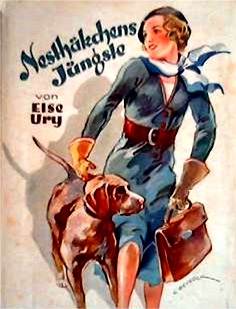Nesthäkchen's Youngest facts for kids
 |
|
| Author | Else Ury |
|---|---|
| Original title | Nesthäkchens Jüngste |
| Illustrator | Robert Sedlacek |
| Country | Germany |
| Language | German |
| Series | Nesthäkchen, volume 8 |
| Genre | Fiction/Adventure |
| Publisher | Meidingers Jugendschriften Verlag |
|
Publication date
|
1924 |
| Media type | Print (Hardcover) |
| Pages | 191 pp (Hardcover edition) |
| Preceded by | Nesthäkchen and Her Chicks |
| Followed by | Nesthäkchen and Her Grandchildren |
Nesthäkchen's Youngest is the eighth book in the popular ten-book Nesthäkchen series by Else Ury. It was published in 1924. The series is about a German girl named Annemarie Braun. She is a doctor's daughter from Berlin. The books follow Annemarie from when she was a baby all the way to her old age. This book, Nesthäkchen's Youngest, focuses on Annemarie's youngest daughter, Ursel. It tells the story of Ursel growing up and getting married.
Contents
The Story of Ursel's Life
This book starts about 15 years after the last one. Annemarie's husband, Rudolf, is now a respected doctor and professor. Their daughter Vronli is a kind and hardworking maternity nurse. Annemarie's nephew, Hans's son, is about to finish school. He wants to be a farmer, not a doctor like his dad. He looks up to his Uncle Klaus, who is a farmer.
The main character in this book is Ursel, Annemarie's youngest daughter. Ursel is seventeen and has just finished school. She is very much like her mother, Annemarie. Ursel has a beautiful singing voice and dreams of becoming a singer. However, her father wants her to work at a bank first.
Ursel's Career Path
This causes some arguments between Ursel and her father. But Annemarie helps them find a solution. Ursel agrees to work at the bank. At the same time, she can take singing lessons from an older opera singer.
Annemarie's brother Klaus is married to Ilse and they have four sons. Her friends Marlene and Peter have three daughters. Annemarie's brother Hans is a bit lonely after his wife, Ola, passed away. He has two lively sons. Annemarie's friend Margot becomes his housekeeper and later, his second wife.
Annemarie's mother is now a widow and has gotten older. Her apartment is too big for just her and her cook, Hanne. So, she takes in guests. Two rich siblings from Brazil, Milton and Margarida Tavares, come to stay. They own a coffee plantation. Milton and Margarida meet Ursel and become her friends. Ursel and Milton fall in love. But Ursel is worried about leaving Germany.
Singing Dreams and Love
Ursel soon finds that she doesn't like working at the bank. She has a disagreement with her boss, which upsets her parents. Luckily, things get better. One of her father's patients, Music Professor Lange, hears Ursel sing. He asks Rudolf to let Ursel go to the Conservatory, a special music school.
Ursel even gets to sing in a big concert when another singer gets sick. It looks like she is about to start a wonderful singing career. But in the end, Ursel realizes that her love for Milton is stronger than her desire to sing professionally. She marries Milton Tavares and moves with him to Brazil. Annemarie is sad to see her go, but she is strong. Ursel sends many letters home, describing her new life. At the end of the story, Ursel becomes a mother to twin girls, Anita and Marietta. Both are named after their grandmother, Annemarie.
Similarities to Other Stories
Nesthäkchen's Youngest shares some ideas with an older book series called Der Trotzkopf. In Der Trotzkopf, the daughter Ruth is very much like her mother, Ilse. In the same way, Ursel is a lot like a younger Annemarie. Both Ruth and Ursel dream of becoming singers.
Even the idea of moving to another country appears in Der Trotzkopf. In that series, Margaret's daughter Marianne gets engaged to Fritz, who is a successful businessman in America. She moves with him to San Francisco. After many years, their American children return to Germany.
About the Book's Style
The Nesthäkchen books belong to a German type of story called a Backfischroman. This means "teenage girl novel." These books describe a girl growing up and were written for readers aged 12 to 16. A "Backfisch" was a young girl, usually between 14 and 17 years old.
The Backfischroman style was popular from about 1850 to 1950. These stories often showed girls learning about traditional social rules. They usually ended with the main character getting married and becoming a Hausfrau, or homemaker.
Why More Nesthäkchen Books?
Besides Else Ury, other famous Backfischroman authors included Magda Trott, Emmy von Rhoden (who wrote Der Trotzkopf), and Henny Koch. Else Ury originally planned to end the Nesthäkchen series with book 6, Nesthäkchen Flies From the Nest. That book described Nesthäkchen's marriage.
However, her publisher in Berlin received many letters from young fans. They begged for more Nesthäkchen stories. After thinking about it, Ury wrote four more books. She even mentioned her first doubts in a note at the end of volume 7, Nesthäkchen and Her Chicks.
About the Author, Else Ury
Else Ury was a German writer who wrote children's books. She was born in Berlin on November 1, 1877. Sadly, she passed away on January 13, 1943, in the Auschwitz concentration camp.
Her most famous character is Annemarie Braun, the blonde doctor's daughter. Annemarie's life, from childhood to old age, is told in the ten very popular Nesthäkchen books. These books, along with a six-part TV show from 1983 and a DVD release in 2005, have been enjoyed by millions of readers and viewers.
Images for kids


